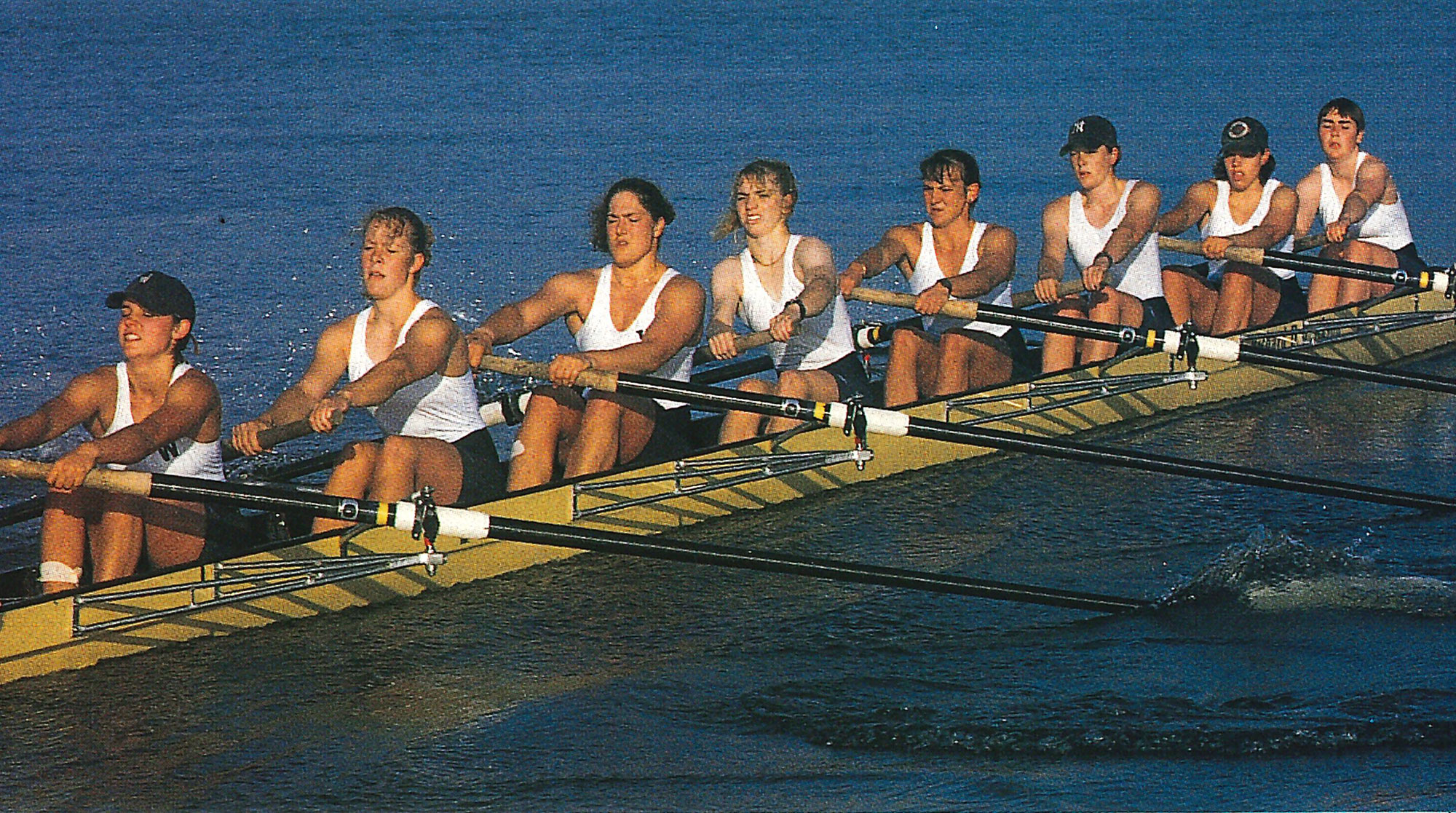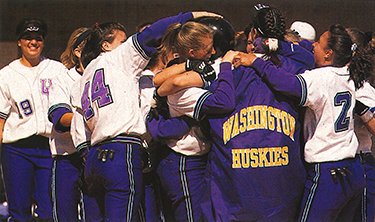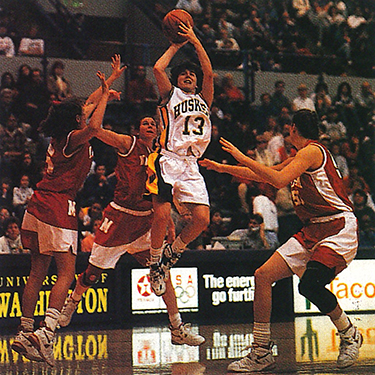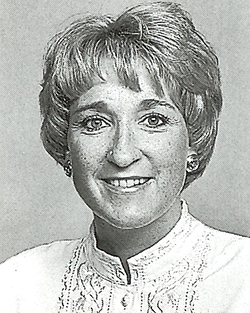Fair play Fair play At the UW, women’s sports are finally on equal footing
The UW's status as a leader in women's sports is the result of its commitment to gender equity.

The UW's status as a leader in women's sports is the result of its commitment to gender equity.
Ask any women's coach at the University of Washington—or anywhere else for that matter—about their days as a college player, and you will hear some great war stories.
Like how they had to pay for their own workout clothes; buy their own sneakers; cram a whole basketball team into a van for a 6-hour drive to play a one-hour game; or drive back at midnight after a game because the team couldn’t afford to spend the night in a motel. Scholarships? Don’t make me laugh.
“It sure was a different time,” says Marie Tuite, who is doing all she can to make sure those stories become the stuff of legend. A former college basketball star who is a senior associate athletic director at the UW, Tuite says, “There’s almost nothing in common between the days when I played and now.”
Today, the women’s basketball Final Four is on television. Women athletes have scholarships and women’s programs have shoe contracts. New fields are being built, programs created, and people are paying more attention to women’s sports.
It hasn’t been this way for long. Women’s sports were often viewed like gum on the bottom of your shoe—something that won’t go away and is just annoying enough to make you pay attention to it. Men’s sports, particularly football and basketball, were always king. Women’s sports programs frequently were devoted to things like field hockey, and mostly on the club level. Picking up a sports page and seeing anything about women’s sports (other than golf and tennis) happened about as often as Halley’s Comet passed by.
Outside of the players, coaches, friends and parents, interest in women’s sports just didn’t seem to exist. And neither did opportunities. But there were the exceptions—many of them on the West Coast. Like its Pac-10 colleagues UCLA, USC and Stanford, the UW has always had a strong women’s sports program. Most notable: the Husky women’s crew team, which has existed as an intercollegiate sport since 1976, has won seven national championships. The UW women’s basketball program has seen nine National Collegiate Athletic Association (NCAA) playoff appearances in 11 years.
Ever since she arrived at Montlake from USC in 1991 as the new athletic director, Barbara Hedges has spearheaded the fight for equality on the nation's playing fields.
In the past few years, the UW has also become a national power in two new sports—women’s softball and soccer. But the UW’s status as a leader in women’s sports isn’t only based on its success on the playing field. Most of it is actually the result of the UW’s commitment to gender equity.
Ever since she arrived at Montlake from USC in 1991 as the new athletic director, Barbara Hedges has spearheaded the fight for equality on the nation’s playing fields.
Gender equity has been the premier subject of debate in the world of college athletics since 1972, when the federal government officially recognized that women were getting short shrift. The federal government passed Title IX of the Education Amendments of 1972, declaring that if programs wanted to continue receiving federal money, they had better start creating equal opportunities for women.
Title IX targeted three areas:
Women’s collegiate sports doubled from 32,000 participants in 1971 to more than 64,000 in 1977, but the rise began to level off, then diminish a few years later when Title IX protections weakened.

The UW women’s softball team congratulates itself after another victory. UW Sports Information photo.
A gender equity task force appointed by the NCAA released a landmark 1993 report which concluded that, despite the 20-year-old law of the land requiring equal opportunities for men and women, “there is clear evidence that it has not succeeded in providing” equal access for women.
“It was downright embarrassing for this industry,” says Tuite, a former NCAA official. “There’s no other way to describe it.”
A number of universities suffered further embarrassment when they were taken to court under gender equity issues. One of the biggest cases was in 1979 when Washington State University was sued by 53 coaches and athletes for violating the state’s anti-discrimination statutes. Plaintiffs claimed inferior treatment of WSU women’s athletics in funding, fund-raising efforts, publicity, scholarships, facilities, equipment, coaching, uniforms and administrative support. A state trial court agreed, ruling that this was a violation of state law against discrimination and the state’s Equal Rights Amendment. The total damages came to $124,000, including interest. Today WSU has eight women’s sports and five men’s programs.
Some other universities who got nailed in court included Texas, which agreed in a settlement to add two sports and increase scholarships; Cornell, which was required to restore the women’s gymnastics and fencing teams; and Auburn, which was ordered to elevate women’s soccer from club level to varsity status, devote hundreds of thousands of dollars for operating expenses, increase scholarships, and build new fields for women’s sports.
The goal mandated by the courts was simple: Institutions should strive to have equal numbers of men’s and women’s athletes. Two strategies were employed: adding women’s sports and cutting men’s sports. Unfortunately, many took the latter action—a move that didn’t sit well with men or women. “We know what it is like not to have opportunities,” says UW Softball Coach Teresa Wilson. “It isn’t fair to men to have their sports cut.”
The UW was not exempt from cutting men’s sports as a way to even out the numbers and keep the program out of red ink. In 1980, the UW men’s gymnastics and wrestling programs were eliminated. “With inflation and our commitment to expand women’s athletics, unless we find new ways to increase our revenues or decrease expenditures, things will be even tougher next year,” former athletic director Mike Lude said at the time.
Other Pac-10 schools cut men’s sports, too. Oregon State cut track 10 years ago and UCLA eliminated crew, for example.
“Our philosophy has been to provide opportunities for women without any negative effect on the men's program.”
Barbara Hedges
The UW hasn’t cut any other men’s sports, and Hedges, who replaced Lude in 1991, made a commitment that it wouldn’t happen again. “Our philosophy has been to provide opportunities for women without any negative effect on the men’s program,” she says. “We are very sensitive to gender equity in all areas—financial aid, academic support, equipment, training, administrative support. And we looked at everything carefully because harming the men’s program is not the way to do it.”
“We wanted to do it the right way.”
To fund the new women’s sports, Hedges was able to use revenue generated by the tremendously successful UW football program (19 consecutive winning seasons, including the 1991 national championship). “We are fortunate to have the resources to support other programs because of football,” she says. “Gate revenue from football and basketball, along with private contributions, has exceeded our expenses. We manage our money well, and it paid off.”
That money—which funds 10 men’s sports as well as all the women’s sports—helped create the new softball and soccer programs for women. Despite the significant startup costs in scholarships, coaches’ salaries and equipment, no cuts were made in men’s sports.
The UW now has more sports programs for women (12) than it does for men (11). But what the NCAA cares about is number of athletes. And in this case football, the golden goose for the UW and every other collegiate athletic program, is also a bugaboo.
Football teams are huge. The UW had 126 players on its football team last year, and there just isn’t a women’s sport with those kinds of numbers. The UW women’s crew team, which has 84 athletes, is the closest. Athletic directors nationwide, struggling to achieve a balance, face a nearly impossible situation because of football.

The UW women’s basketball team is one of the school’s highest profile female teams. UW Sports Information photo.
Many have lobbied to remove football—jokingly referred to as “the third gender”—to give the rest of the sports (basketball and the other Olympic or so-called “minor” sports, such as swimming, track and field, crew, volleyball and soccer) a better chance of evening up men’s and women’s numbers.
“Football throws it all out of whack,” says Tuite, who oversees the UW’s Olympic sports. “There is almost no way to make up for the 120 players on a football team. You either need sports with high numbers of players, like crew, or you need a lot of sports. The big problem is how.”
In her fifth year on the job, Hedges is ahead of the goal she had of achieving a 60/40 balance between men’s and women’s athletes. Of the 275 student-athletes on scholarship at the UW, 156 are men (56.7 percent) compared to 119 women (43.2 percent). Of the 664 athletes playing UW sports in 1995, 357 were men, 307 women. While the UW’s total enrollment was made up of 50 percent women, women made up 46 percent of the UW’s athletes.
“The UW has done a great job,” says Pac-10 Assistant Commissioner Jim Muldoon. “Especially with the new soccer and softball programs. It is a remarkable story to add a new sport and have it become a national leader in such a short time.”
Teresa Wilson was hired in 1992 to coach the softball team a full year before her squad stepped on the field. She had the rare opportunity to hire assistants, start recruiting and get equipment ready far in advance of the first pitch. She was thrilled not only to create her program from scratch, but to know she had the commitment from the UW athletic administration.
It paid off big-time. In May, the Huskies, in only their fourth year, made it to the NCAA championship game, losing to No. 2 Arizona. In four years, the UW softball team has a 184-80 record (.696 winning percentage), including 59-9 last year.
Wilson didn’t always enjoy that kind of success. When she coached at Oregon from 1986-1989, she had to devote much of her time and energy to raising money. “We only had six scholarships, and it was not a well-funded program,” she recalls. “It was very frustrating. Everyone agreed the women were grossly behind the men. That was ridiculous.” So she left for the University of Minnesota, where she spent two years and had considerably more support. But the lure of coming to the Pac-10—which has captured eight of the past 10 national titles—to build a brand new program was too enticing to pass up.
At the UW, she has 11 scholarships. But there was one problem: Her team had no field of its own. The lack of facilities is a common stumbling block when it comes to adding women’s sports these days—at the UW and elsewhere.
For two years, 20 UW softball players had to jam into two vans for the drive across the 520 floating bridge to Bellevue for its 3:30 practice. Battling rush-hour traffic to make it back by the 7 p.m. study hall was always a challenge.
“It was a nightmare sometimes,” Wilson says. The new softball complex she was promised was delayed a couple of times, adding to her frustration. “Recruiting isn’t easy when you can’t show players where they will play,” Wilson says.
At the end of the 1996 season, the team got to play a few games in its new $3 million complex. Though it is not finished, the softball stadium (which will seat 1,000) will be part of a $7 million softball-baseball complex along the shores of Lake Washington northeast of Husky Stadium.
“Facilities are the most important part of the equation,” says Lesle Gallimore, the UW women’s soccer coach for the past two years. She, too, has no field of her own. Gallimore is here because her predecessor, Dang Pibulvech, left for Texas. He said he was fed up with the lack of soccer facilities. Still, the lack of a home field hasn’t hindered the UW team too much—in its six years, the women soccer team has a record of 64-43-8.
The women’s soccer team isn’t alone here. The men have no field, either. But help is on the way. Construction on phase one of a new soccer facility for both teams commences this October. Galimore’s team—which advanced to the second round of the NCAA playoffs in 1996—likely will play its seven home games off campus in the upcoming season.
But the lack of a field is minor compared to what Galimore encountered while coaching at San Diego State. There, scholarship money was taken from the men’s team and given to the women’s, and coaching cutbacks left one coach in charge of both teams. It created a difficult atmosphere for everybody.
“Here, things are equal,” Gallimore says. “There is no disparity in what we get. And everyone works together well,” she says, referring to the fact that her team has been able to use some of the football team’s practice fields. “I am optimistic about the future, too. This school and the area are rich in soccer tradition, and my goal is that women’s soccer become self-sustaining. We are like the little brothers and sisters of football, but we want to pull our own weight.”
In the larger picture, the UW is certainly doing that. Not only is Hedges one of handful of woman athletic directors leading NCAA Division I programs, but she is the first woman president of the National Association of Collegiate Directors of Athletics.
“This was a place I had to be a part of,” says June Daugherty, the new UW women’s basketball coach. “Women athletes of today have it so good because of all the hard work that was done in years past. But here at the UW, we are a leader because we do things right. And the fight to give women more opportunities will continue.”

June Daugherty
Ice cream and party hats were the order of the day on May 10 for June Daugherty. Not only did her twin children celebrate their second birthday, but she was named the new women’s basketball coach at the University of Washington.
Daugherty thus took the helm of one of the nation’s premier and high-profile women’s college basketball programs after building an impressive record during seven years at Boise State. There, she turned a small program into a winner, with a 123-74 record in seven seasons, guiding the Broncos’ to their first NCAA tournament appearance. But she is no stranger to the Pac-10 — she was an assistant at Stanford from 1985-1989 before getting the Boise State job.
Daugherty, who signed a four-year contract, replaces Chris Gobrecht, who left in April to become the head coach at Florida State. Gobrecht led the Huskies to a 243-89 record and nine NCAA tournament berths in her 11 years. Daugherty’s husband, Michael, who was her assistant coach at Boise State, will assist her here.
Fans will notice a change inside Hec Edmundson Pavilion when they watch the Husky women’s basketball team take the court. Daugherty brings with her a wide-open offensive style, quite a contrast to the intense, defense-oriented approach Gobrecht used.
“We are going to run and take advantage of the athletes we have here,” she says. With a solid nucleus of last year’s 16-11 Husky team—led by returning guards Jamie Redd and Laurie Savasta—Daugherty may need to get ready to celebrate next March.